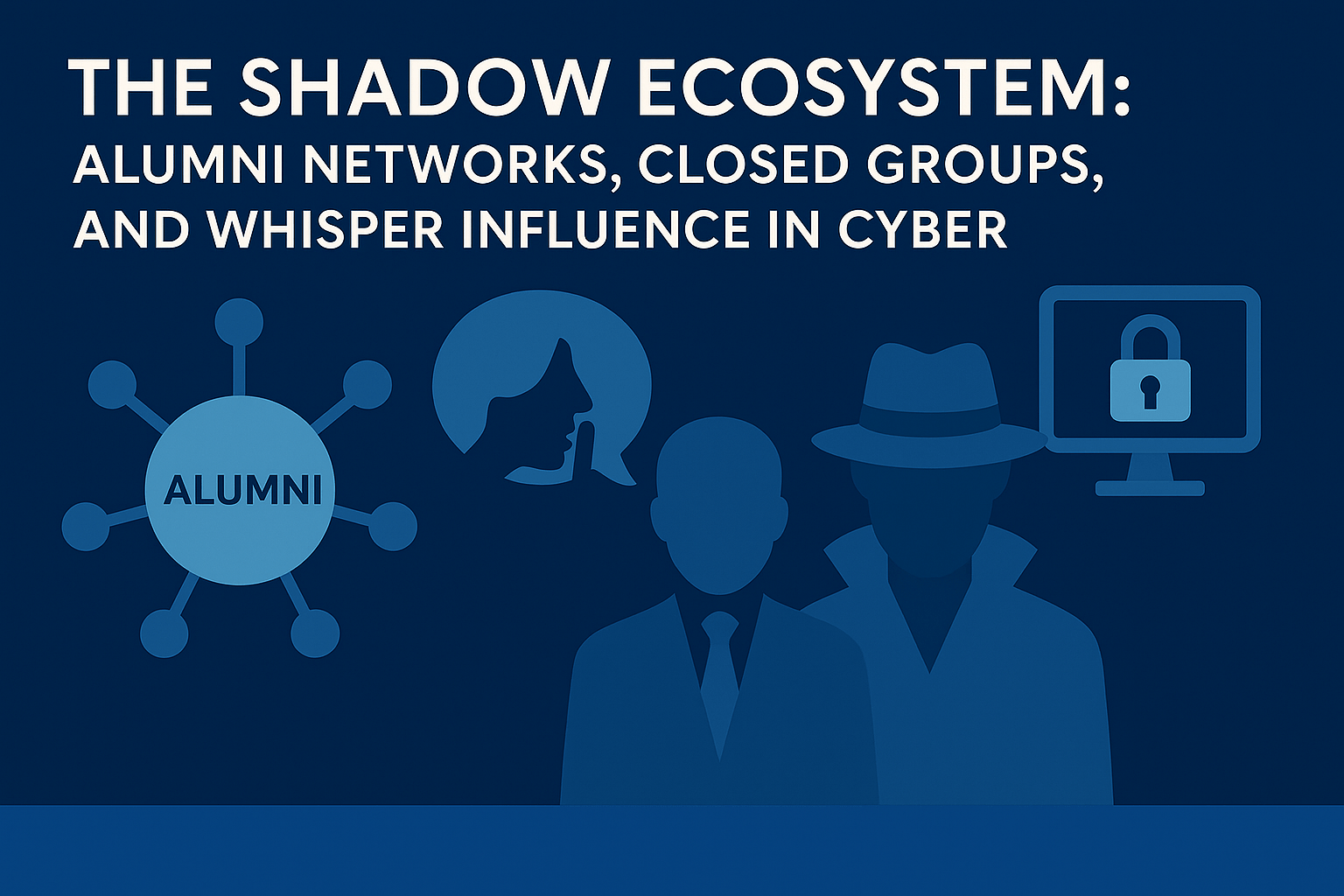Beyond public policy and LinkedIn posts lies a quiet web of influence, trusted groups, off-book referrals, and unseen signals that shape who gets funded, hired, or heard in UK cybersecurity. Cybersecurity in the UK has a formal face: policy frameworks, standards bodies, public panels, and professional networks. But beneath that, there exists a shadow ecosystem, informal, invitation-only, and often more influential than any official organisation. This is where reputations are made (or unmade), where partnerships are brokered before anyone sees a press release, and where quiet nods matter more than job titles. This article explores the informal infrastructure of UK cyber influence, the alumni groups, private chat channels, Slack collectives, and backchannel referrals that quietly shape decisions in hiring, procurement, investment, and policy.
Contents
- Contents
- 1. NCSC & GCHQ Alumni Networks
- 2. Closed Signal & WhatsApp Groups
- 3. Former Colleague Loyalty and Referral Loops
- 4. Academic-Industry Power Nodes
- 5. Slack Collectives, Discord Servers, and Dark Social
- 6. Speaker Circuits and Side-Door Events
- 7. Invisible Metrics of Trust and Legitimacy
- 8. Why This Matters
- How to Earn Access (Without Faking It)
- Final Thoughts
- References
1. NCSC & GCHQ Alumni Networks
- Alumni of the National Cyber Security Centre (NCSC) and GCHQ are embedded across the UK cyber ecosystem, from Big Four firms and FTSE100 CISOs to startup founders and think tanks.
- Many maintain informal but active links through:
- Secure group chats (Signal, Wire, Matrix)
- Private WhatsApp groups for former cyber operatives
- Alumni-only briefings and reunions
Why it matters: When these individuals speak, people listen. Not for name recognition, but because they carry credibility in threat intelligence, incident response, and public duty.
2. Closed Signal & WhatsApp Groups
These chat groups operate like distributed, informal CISOs’ clubs. Themes vary:
- Incident Response Backchannels – “Has anyone seen this IOC in the wild?”
- Procurement Signals – “Any red flags on Vendor X?”
- Vulnerability Sharing – “Patch now. Here’s why, off record.”
- Policy Pulse – “Heard from DSIT that…”
Access is typically invite-only, governed by trust, often via introductions through shared professional history.
3. Former Colleague Loyalty and Referral Loops
In an industry where trust is paramount, former colleagues often reappear:
- Ex-Army cyber specialists now in consultancy recommend ex-forces startups
- Civil servants moving into the private sector bring their old network with them
- DSIT programme leads refer “known entities” when shaping early-stage funding bids
Result: Procurement panels, pitch invitations, and advisory boards often reflect this web, not favouritism, but quiet vetting based on lived delivery.
4. Academic-Industry Power Nodes
- Long-running research partnerships, especially those born from CyberASAP, NCSC i100, or EPSRC-funded centres, often continue long after funding ends.
- Informal alliances between professors and CTOs or policy leads help shape:
- Funding directions
- Ethical boundaries
- Spinout support and adoption
Influence here flows through co-authored papers, late-night proposal reviews, and quiet policy commentary ahead of consultation windows.
5. Slack Collectives, Discord Servers, and Dark Social
- Groups like CyberPeople, Ladies of London Hacking Society, cybersecHQ, and Neurodivergent in Cyber often coordinate over Slack or Discord
- These are more than support groups, they’re recruitment nodes, speaker rosters, and peer-review rings for funding bids and public briefings
- High-trust, peer-led, and self-policed, often more effective than large public forums
6. Speaker Circuits and Side-Door Events
- Events like SASIG, BSides, or Chatham House-style industry roundtables offer informal speaking slots for trusted voices
- Being invited (and re-invited) is itself a signal of credibility
- Decisions to back a startup, endorse a vendor, or partner on a project often start after these sessions, over coffee, Slack, or signal DMs
7. Invisible Metrics of Trust and Legitimacy
In the shadow ecosystem, people are assessed by:
- Who vouches for them, not where they work
- How they’ve acted under pressure, incidents, media storms, project failures
- Who they’ve helped quietly, without credit
- What they don’t post on LinkedIn
8. Why This Matters
This shadow ecosystem isn’t shadowy in a nefarious sense, it’s an organic trust infrastructure in a high-risk field. It fills the gaps formal institutions can’t:
- Speed in incidents
- Context in hiring
- Realism in vendor assessments
- Nuance in policy interpretation
To ignore it is to miss the actual pathways of influence in UK cyber.
How to Earn Access (Without Faking It)
- Show up for others, give advice without expectation
- Volunteer for unpaid work, review a proposal, chair a session, host a panel
- Speak with clarity and humility, no buzzwords, just value
- Let others vouch for you, reputation here is transferred, not self-proclaimed
Final Thoughts
Behind every cyber panel, funding call, or vendor shortlist is a quieter layer of influence: people who trust each other, who’ve delivered together, and who share intel without ego or agenda.
In the UK’s cyber ecosystem, real power often travels by whisper.
References
- Inside the UK Cyber Ecosystem: A Strategic Guide in 26 Parts
- The Insider’s Guide to Influencing Senior Tech and Cybersecurity Leaders in the UK
- The Shadow Ecosystem: Alumni Networks, Closed Groups, and Whisper Influence in Cyber
- The Quiet Power Players of UK Cybersecurity: Who Really Shapes the Agenda?
- What CISOs Really Read: Reports, Forums, and Signals That Shape Decisions
